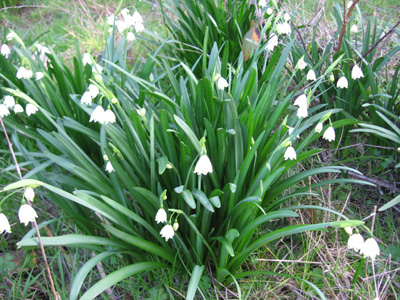Since it’s the weekend and Melissa is here to play photographer and uploader, I have new pictures to post. (I will be doing my own photography one of these days, but as an old dog I want to wait and learn this new trick once the academic year is over.)
Here’s the Horse Shoe Cable Hat I knit up in a child’s size using the pattern by Lydia of Dropped a Stitch. My friend Boaz, who was having a squirmy kind of morning, is doing the modeling. We played the “put-the-hat-on, whip-the-hat-off” game, which resulted in much laughter and many blurry photos. (You may notice that the blurrier the photo, the bigger his grin—there’s some sort of correlation going on there.)
Complete blur:

Partial blur:

Minor blur:

We were indoors when we took these pictures, and I think he found a hat inside the house unnecessary. One of these days when we head outdoors to play, we’ll have to try to get a completely clear shot.
I knit the hat in Rio de la Plata’s Twist, color TS-96. I’m looking forward to knitting it up again in an adult size with bigger needles and a heavier guage yarn.
After two evenings of playing with Hello Yarn‘s Generic Norwegian Hat chart, I’ve now started a semi-Norwegian hat of my own design. I’m working with Knit Picks yarn, as I often do for my “one-offs” when I haven’t finalized a pattern, as the price is unbeatable. I’m using Gloss in Pumpkin as the main color and Memories in Redwood Forest for the contrast. My design is fairly simple: a pair of overlapping oak leaves with a cross-hatched background pattern. Originally, I’d thought I’d include some acorns as well, but, interestingly enough, they were much more difficult to chart than the oak leaves. They have a simpler shape, and the simplicity actually makes them harder to render effectively.
I’ve realized that charted multi-colored knitting will allow me to draw on all my years of doing folk-art style counted-thread embroidery. Up till now, I’ve been thinking of knitting as being about shape and texture, but intarsia opens knitting up to being about image as well. (And text—check out this sweater and also this one, both by Lisa Anne Auerbach.)
As I’ve mentioned, I earn my living teaching writing at UC Santa Cruz. When I walk to my office, I see this. (That’s my office door in the background, just to the left of the redwood trees.)

If I make a 180-degree turn while walking to my office, I often see something like this.

Even with 200 or so pages of essay-reading most weekends, basically, it’s paradise.
I’ve kept a “mammal list” of my workplace sightings. Particularly in the summers, when the number of students decreases, one can encounter all sorts of creatures:
Ground Squirrels (These are ubiquitous.)
Deer (These are an everyday sighting, and I often see mothers with fawns—singles or twins—in the spring and summer.)
Foxes
Skunks (I was once in a line of half a dozen cars that came to a complete stop while a group of five or six skunks held a caucus in the middle of the road, running in cicles and chattering like mad at one another.)
Raccoons
Coyotes
Bob Cat (From a distance I thought it might be a lost housecat, so I parked my car and went to investigate. When I got to within twenty feet of it, it stood up, at which point I realized this was no house cat. It shot me an “I-could-take-you-out-if-I-wanted-to” look and slowly ambled off into the brush.)





